Honor of Kings vs League Mobile: Full Comparison for Gamers
Updated On: October 25, 2025 by Aaron Connolly
Key Differences Between Honor of Kings and League Mobile
Both games stick to the classic 5v5 MOBA formula. Honor of Kings leans into strategic depth and Chinese mythology, while League Mobile (Wild Rift) brings faster-paced matches and familiar PC League champions.
Core MOBA Gameplay Overview
Honor of Kings puts the spotlight on team-based combat and longer matches — expect 15-20 minutes per game. Players need to plan ahead and actually coordinate if they want to win.
League Mobile goes for quick, punchy gameplay. Most matches wrap up in 10-15 minutes, which just feels right for mobile.
The controls feel pretty different. Honor of Kings sticks with classic MOBA mechanics and manual targeting. League Mobile streamlines things with more auto-targeting, so it’s a bit easier to pick up and play.
Combat pacing is where these two really diverge. Honor of Kings rewards patience and smart positioning. Wild Rift pushes you to make snap decisions and jump into fights more often.
Both games keep the core MOBA setup: three lanes, towers to defend, and bases to destroy.
Objectives and Map Design
The maps look similar at first — three lanes, jungle in between — but each game tweaks the formula. Honor of Kings gives you a bigger map, more jungle camps, and some sneaky chokepoints.
Jungle monsters play different roles:
- Honor of Kings: More monster types, more variety in buffs
- League Mobile: Simpler jungle, familiar buffs
Both games have their own versions of Dragon and Baron. Honor of Kings calls them “Dark Slayer” and “Turtle.” League Mobile just sticks with Dragon and Baron Nashor.
Tower mechanics aren’t quite the same. Honor of Kings towers regenerate shields, so sieges need more planning. League Mobile’s towers work more like PC League.
Vision control? League Mobile uses wards, just like on PC. Honor of Kings shakes it up with bushes and terrain that blocks sight.
Role and Class Variations
You’ll see the same five core roles in both games: Tank, Fighter, Assassin, Mage, Marksman, and Support. The hero designs, though, reflect each game’s roots.
Honor of Kings brings over 80 heroes, many inspired by Chinese mythology. You get to play as Sun Wukong or Mulan, which is honestly pretty cool.
League Mobile lets you pick from familiar faces like Jinx, Yasuo, and Ahri, but with tweaks for mobile.
Role flexibility feels different. Honor of Kings lets you experiment more with hybrid roles. League Mobile keeps things stricter, following the PC game’s structure.
Champion complexity? Honor of Kings keeps most abilities simple for mobile. Wild Rift keeps the complexity of PC League, though it’s a bit toned down for touchscreens.
Skill expression is there in both, but you’ll notice it comes out in different ways.
Gameplay Mechanics Showdown
Honor of Kings and League of Legends Mobile both give you that classic 5v5 MOBA action. But their mechanics really shape how each game feels to play.
Match length, strategic depth, and map design all add up to two pretty different vibes.
Pace and Match Duration
Honor of Kings is built for fast mobile sessions, with games running 15-20 minutes. The mechanics push you to level up and get gold quickly, so fights break out sooner.
League of Legends Mobile, on the other hand, goes longer — usually 25-35 minutes per match. That gives you more time for strategy and big comebacks.
Quick comparison:
- Honor of Kings: Gold and levels come fast
- League Mobile: Slower, more traditional pacing
Shorter games in Honor of Kings work great if you’re playing on the go. You can squeeze in a match during a commute or while waiting for coffee.
League Mobile’s longer matches cater to players who want deeper strategy. The extra time lets you try more team comps and really play for the late game.
In-Game Strategies
Honor of Kings pushes for early aggression and constant fighting. You’ll find yourself in team skirmishes pretty much all game long.
Objectives pop up often, so teams have to keep clashing for control. The result? More action, fewer dull moments.
League Mobile sticks closer to classic MOBA strategy. Teams farm up, then contest objectives at key moments.
Strategic differences:
- Honor of Kings: Aggressive play, lots of team fights
- League Mobile: More farming, calculated fights
- Map control: Both need vision, but timing is different
The support role in Honor of Kings doesn’t just babysit a lane. Roamers move all over, so games feel less predictable.
Map Elements and Lanes
Both titles use the classic three-lane map with jungle in between. Honor of Kings shrinks the map, though.
The smaller map in Honor of Kings cuts down on travel time. You can rotate quickly and group up for fights more often.
League Mobile’s bigger map offers more space for strategy. You get more chances for split-pushes and sneaky plays.
Map features comparison:
| Element | Honor of Kings | League Mobile |
|---|---|---|
| Map size | Compact | Traditional |
| Jungle camps | Faster respawns | Standard timing |
| Objectives | More frequent | Strategic spacing |
| Lane distances | Shorter | Traditional MOBA |
Honor of Kings’ jungle lets you farm and rotate faster. Monsters respawn quickly, so the pace stays high.
5v5 Battles Explained
Both games center on 5v5 team battles, but the fights play out differently. Honor of Kings brings shorter, explosive team fights.
Crowd control in Honor of Kings doesn’t last as long, so fights keep moving. You’re not stuck waiting to act for ages.
League Mobile sticks with longer crowd control, so team fights last longer and positioning matters more.
Team fight characteristics:
- Burst potential: Honor of Kings lets you delete enemies fast
- Sustained fights: League Mobile gives you drawn-out brawls
- Positioning: Both care about it, but the timing is different
Honor of Kings hands out shorter ultimate cooldowns. You’ll see multiple ults in a single fight, which makes things wild.
Items work differently too. Honor of Kings items give you quick power boosts. League Mobile’s items build up over time, so you plan ahead more.
Heroes and Character Roster
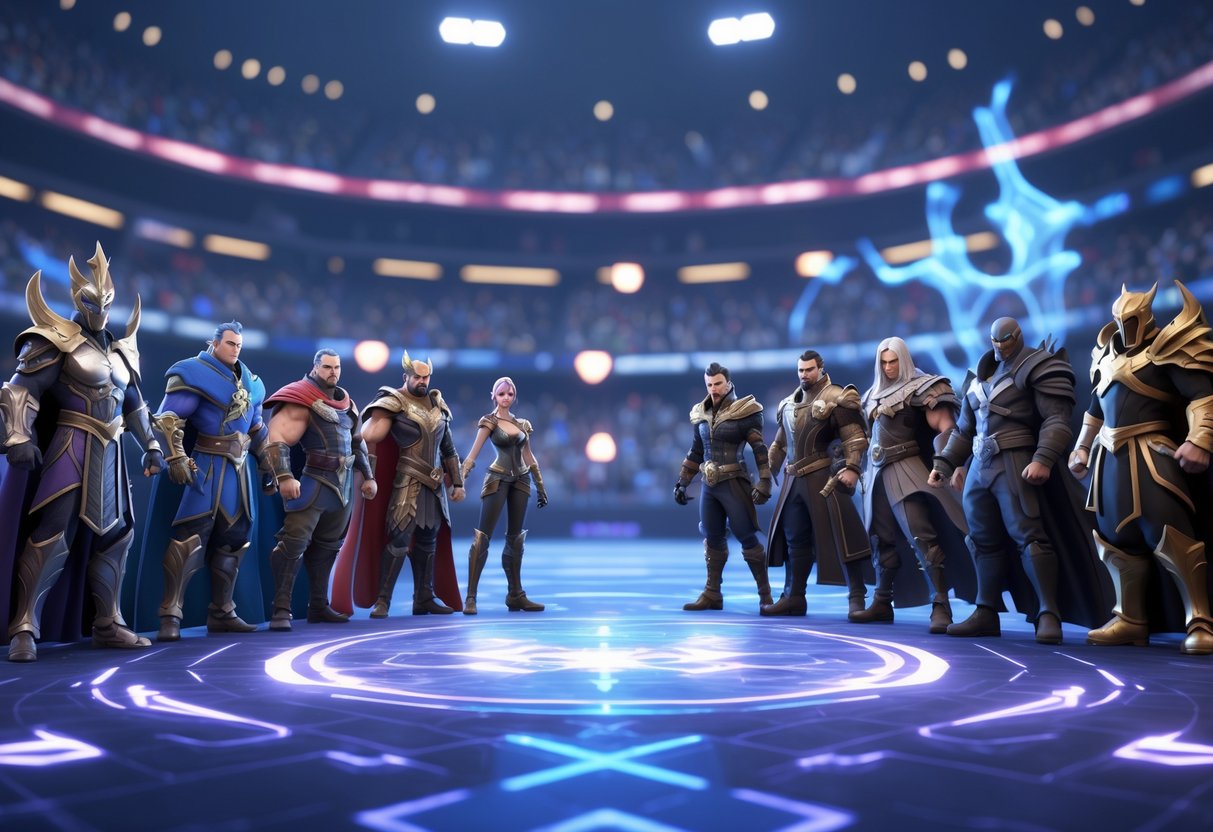
Both games offer massive hero selections — more than 120 characters each. Each game splits heroes into clear classes, but Honor of Kings leans hard into Chinese mythology while League keeps its fantasy vibe.
Diversity of Heroes
Honor of Kings shows off a roster packed with Chinese history and legend. You get to play as famous figures like Guan Yu and Lu Bu, or even mythical beasts.
The whole game carries a strong cultural theme. Most heroes pull from folklore and ancient stories, which gives the game a unique look.
League of Legends Mobile sticks to its established fantasy universe. Champions like Jinx, Yasuo, and Ahri come with their own stories and regions.
Both games drop new heroes often. Honor of Kings adds 15-20 each year, while League Mobile brings in champions from PC and sometimes throws in a mobile exclusive.
Quick win: Try out heroes from different backgrounds in both games before you buy skins or premium stuff. You might find a new favorite.
Hero Classes and Roles
Both games use similar role systems:
| Role | Honor of Kings | League Mobile |
|---|---|---|
| Tank | Warrior/Support | Tank |
| Damage | Mage/Marksman | Mage/ADC |
| Jungle | Assassin | Jungler |
| Support | Support | Support |
Honor of Kings makes assassins stand out more from other damage dealers. This helps new players build better teams.
League Mobile sticks to its classic classes. Each role comes with its own items and playstyle, so PC players feel right at home.
Warning: Don’t assume similar-looking heroes play the same way in both games. Test them out in practice — trust me, it’ll save you some frustration.
Hero Abilities and Skills
Honor of Kings keeps abilities straightforward for mobile. Most heroes get four skills, including an ultimate, and the cooldowns are short so you’re always doing something.
Abilities in Honor of Kings feel fast and forgiving. Skill shots are wider, so you don’t have to be pixel-perfect on a touchscreen.
League Mobile adapts the PC abilities for mobile, but it keeps the complexity. Champions like Azir or Yasuo still have their signature mechanics, just tweaked for tapping.
Both games let you customise with Arcana (Honor of Kings) or Runes (League Mobile). These give you stat tweaks before matches start.
Some abilities feel familiar between games but have different names. Flash in Honor of Kings works like Flicker elsewhere — a quick teleport for escapes or surprise attacks.
Matchmaking System and Player Experience
The two games tackle matchmaking and player experience pretty differently. Honor of Kings usually gives you more balanced matches and less toxicity, while League of Legends: Wild Rift focuses on strict skill-based matching — but that can feel more intense.
Queue Times and Fairness
Honor of Kings gets you into games fast. We usually see matches start in under a minute during peak hours.
The ranking system mixes your individual performance and win rate. This helps keep skilled players from getting stuck with bad teammates.
Wild Rift takes a little longer to find matches, especially at higher ranks. Sometimes you’ll wait 2-3 minutes if it’s a slow time of day. The upside is you get more even matches.
Wild Rift’s matchmaking puts skill matching above speed. You rarely get matched with players more than a rank away. That makes games more competitive, but it can be annoying if you just want a quick game.
Honor of Kings sometimes pairs you with players above or below your rank, though they’ve been working on this. It’s not perfect, but it’s improving.
Communication Features
Both games let you mute chat and block toxic players. Seriously, don’t be shy about using these features.
Honor of Kings gives you pre-set communication wheels. These work great if your team doesn’t speak the same language — you can ping tactics, warnings, or encouragement.
Wild Rift’s ping system is more detailed, carried over from PC. You can mark locations, warn about missing enemies, or coordinate without typing a word.
Honor of Kings feels less toxic than most mobile MOBAs. The newer player base and strong moderation make a difference.
Wild Rift’s community can be a bit tougher. Since it’s tied to PC League, players expect more from teammates and don’t always have patience for mistakes.
Beginner Friendliness
Honor of Kings does a great job welcoming new players with simplified tutorials and gradually introducing new skills. The learning curve feels manageable, even if you’ve never played a MOBA before.
For the first 20-30 matches, new players get extended protection from experienced opponents. This stops those crushing games where beginners get stomped by veterans.
Wild Rift expects you to know a bit about MOBAs from the start. The tutorial only covers the basics and skips deeper stuff like wave management or jungle timing.
Both games include practice modes where you can experiment safely. In Honor of Kings, the AI teammates actually help, but Wild Rift’s bots get pretty predictable after a few rounds.
Honor of Kings offers clearer visual feedback for newcomers. Ability effects and environmental cues stand out more, so team fights feel less overwhelming.
Wild Rift rewards players who stick with it and learn the complex mechanics. The skill ceiling is higher, but it takes longer to get comfortable compared to Honor of Kings.
Graphics and User Interface
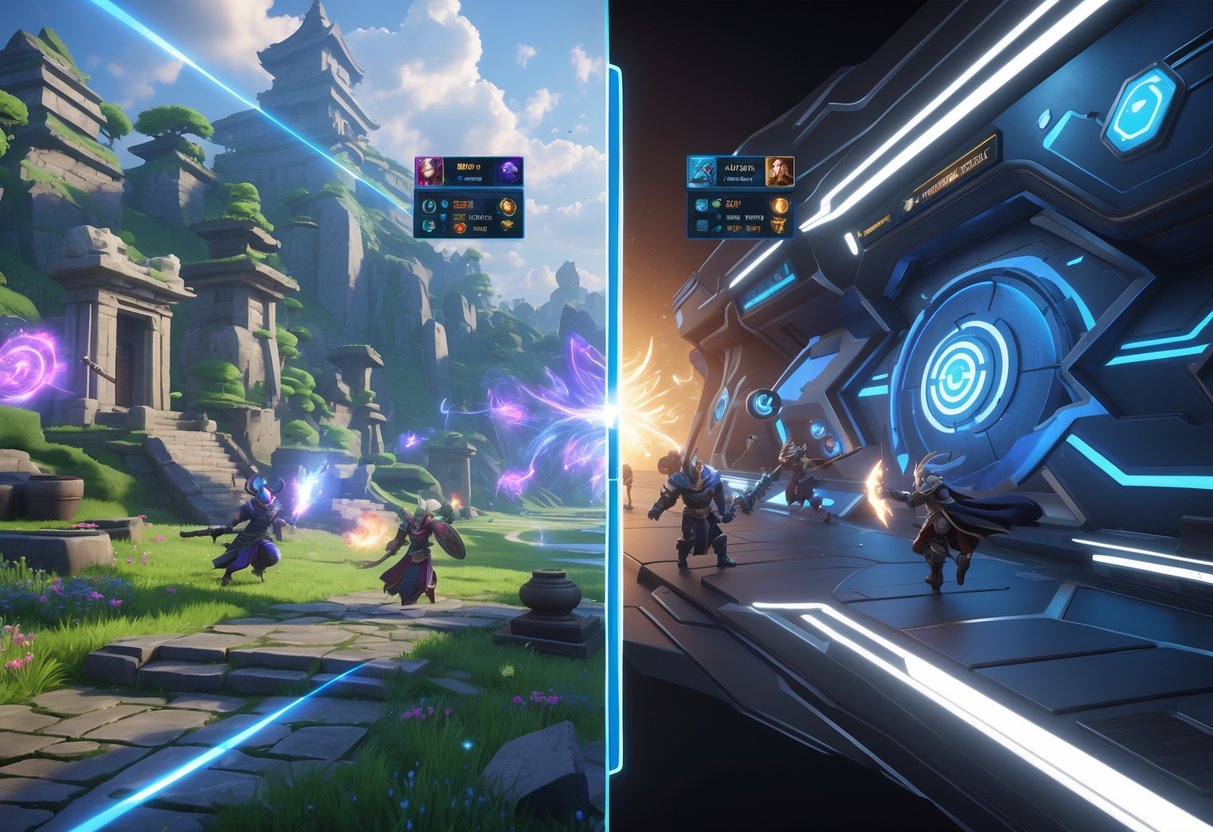
Honor of Kings brings detailed character models and rich effects to the table, while League Mobile sticks with Riot’s polished art style. Both games handle mobile performance well, but they approach optimisation differently.
Visual Quality and Style
Honor of Kings really pushes mobile gaming graphics. The character designs show off intricate armour and weapons, making each hero pop.
Battle visuals get pretty wild. Spell animations burst with colour and detail, and team fights fill the screen with cinematic particle effects.
The art style leans heavily into Chinese mythology and culture. Heroes like Lu Bu look like they stepped out of a legend, which gives the game a unique identity compared to Western MOBAs.
League Mobile goes for a different vibe. Riot keeps things clean and polished, but not as flashy as Honor of Kings. The models stick to that familiar League of Legends look.
The colours are bright and easy on the eyes. Visual clarity takes priority, so you can track abilities and positioning even when things get hectic.
Performance on Mobile Devices
Honor of Kings demands a bit more from your phone because of its enhanced graphics. Most mid-range phones from the last couple of years handle it, but older devices might struggle with frame rates in big fights.
You can tweak the graphics settings to fit your device. Even on lower settings, the game still looks pretty good and runs smoothly.
High graphics settings will drain your battery faster. If you’re planning a long session, you’ll probably want your charger nearby.
League Mobile runs smoothly on a wider range of devices. Riot made sure older phones can still keep up, so even a three-year-old device won’t have too much trouble.
The interface adapts well to different screen sizes. Touch controls feel snappy, and button placement fits how we naturally hold our phones.
Both games download extra content after installation. Honor of Kings takes up more storage, thanks to its higher-res textures and detailed hero models.
Competitive Esports Scenes
Both games have built strong tournament ecosystems. Honor of Kings dominates China with the King Pro League, while League of Legends Wild Rift runs through regional MPL structures worldwide.
Official Tournaments and MPL
Honor of Kings runs the King Pro League (KPL), which draws millions of Chinese viewers. The KPL offers huge prize pools and attracts top-tier talent.
Wild Rift uses Mobile Premier League (MPL) systems in different regions like Indonesia and the Philippines. Each MPL leads up to the Wild Rift Icons global championship.
Their tournament structures feel pretty different. Honor of Kings focuses on China, with some international events, while Wild Rift spreads its attention across Southeast Asia, Europe, and beyond.
Prize pools vary a lot:
- KPL tournaments often go over $1 million
- Regional MPL events usually range from $50,000 to $200,000
- Wild Rift Icons can match the biggest KPL events
Esports Growth and Support
Honor of Kings benefits from Tencent’s huge investment in Chinese esports. Pro teams get training facilities, coaching, and tons of media coverage. The game’s deeper mechanics keep serious competitors coming back.
Wild Rift leans on Riot Games’ esports experience from League of Legends PC. They bring in their broadcast skills, player development programs, and global tournament know-how.
Support looks like this:
- Honor of Kings: Heavy investment in China, growing global push
- Wild Rift: Spread-out support, using established systems
Both games still run into the mobile esports legitimacy debate. Some traditional esports fans just don’t take mobile competitions as seriously as PC gaming.
Community and Player Base
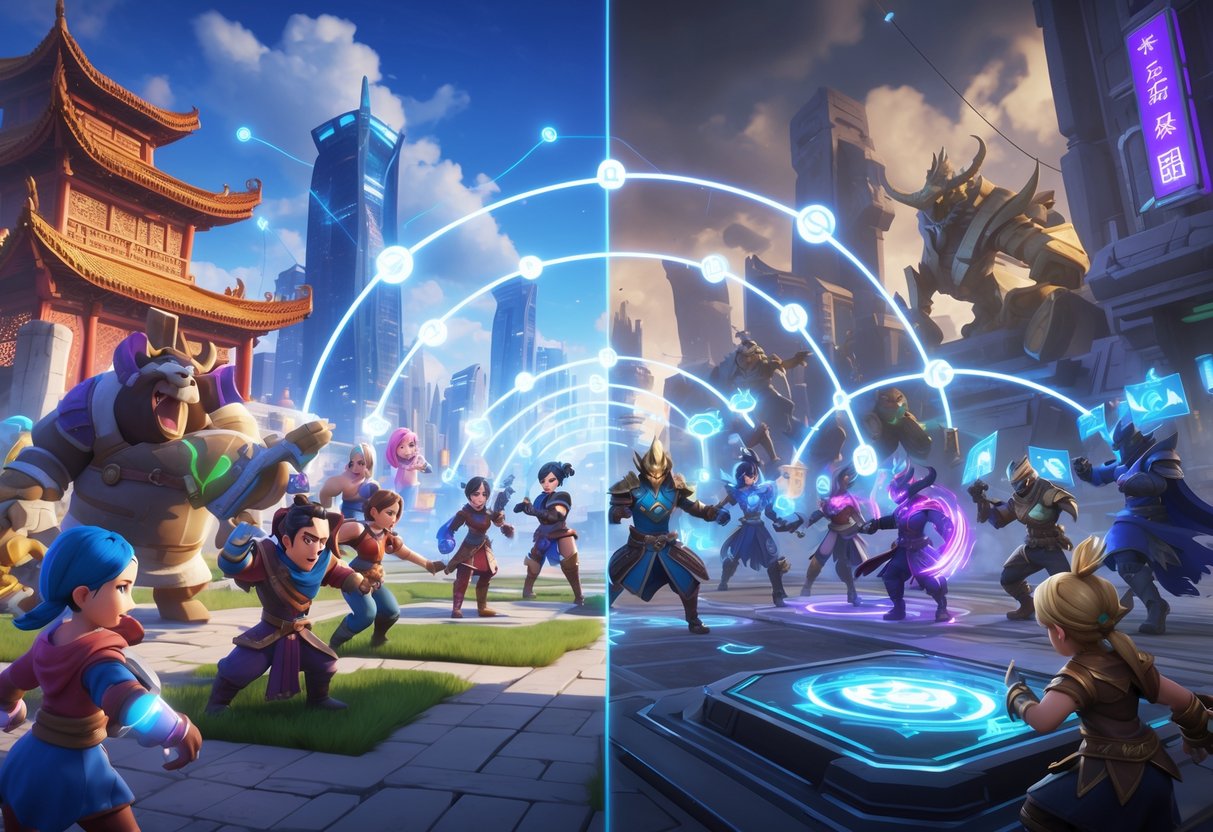
Both games have massive followings, but they shine in different regions. Honor of Kings rules Asian markets, while League of Legends: Wild Rift does better in Western territories.
Popularity by Region
Honor of Kings absolutely dominates the Asian gaming scene. Over 100 million people play daily in China alone. South Korea, Japan, and Southeast Asia also love the game.
Top Asian markets:
- China (main market)
- South Korea
- Taiwan
- Vietnam
- Thailand
Wild Rift aims for global expansion. It’s popular in Europe, North America, and Latin America. Riot’s established League PC fanbase helps boost mobile adoption.
Wild Rift’s big regions:
- United States
- Brazil
- Germany
- France
- United Kingdom
Active Players Worldwide
The numbers tell a pretty clear story about mobile MOBA tastes. Honor of Kings claims about 100 million daily active users worldwide, with most coming from Asia.
Wild Rift sits at around 50 million monthly active players globally. The slower rollout slowed initial growth, but Riot focuses more on quality than raw numbers.
Player engagement:
- Honor of Kings: More daily play sessions
- Wild Rift: Players spend more time per session
- Both: Strong tournament viewership
Regional preferences really shape these communities. Asian players go for Honor of Kings’ fast-paced matches. Western players lean toward Wild Rift’s deeper strategy and familiar champions.
The esports scenes reflect these splits. Honor of Kings pulls in huge Asian viewership, while Wild Rift does better in Western and global events.
Developer Support and Updates

Honor of Kings and League of Legends mobile both get regular updates and strong developer support. TiMi Studio Group keeps Honor of Kings fresh, while Riot Games rolls out frequent patches for Wild Rift.
Patch Frequency and Improvements
TiMi Studio Group updates Honor of Kings every 2-3 weeks. They bring hero balance tweaks, new characters, and gameplay improvements almost constantly.
At global launch, the game offered 85 heroes. TiMi gives 28 more heroes for free if you stay active, which shows they want to grow the player base.
League of Legends: Wild Rift updates about every two weeks. Riot brings champion adjustments and new features at a steady pace.
Comparing updates:
- Honor of Kings: 2-3 week cycles, hero-focused
- Wild Rift: 2 week cycles, champion and systems updates
TiMi has put big money into Honor of Kings’ esports. They’ve invested $15 million and run tournaments with $3 million prize pools, like the Saudi Esports World Cup.
Feedback and Community Engagement
Honor of Kings keeps community channels active on social media. TiMi talks with players through developer talks and behind-the-scenes videos.
Developers even travel to meet players. TiMi’s content team visited Chengdu, China, to film interviews about hero backstories and art design.
Wild Rift uses Riot’s feedback tools. Players can report issues in-game, and Riot responds through official channels.
Community features:
- Honor of Kings: Dev interviews, social media, regional events
- Wild Rift: In-game feedback, dev blogs, forums
Both games offer customer support in several languages. Honor of Kings now supports 14 languages worldwide, and Wild Rift covers all major regions with localised support.
Seasonal and Special Events
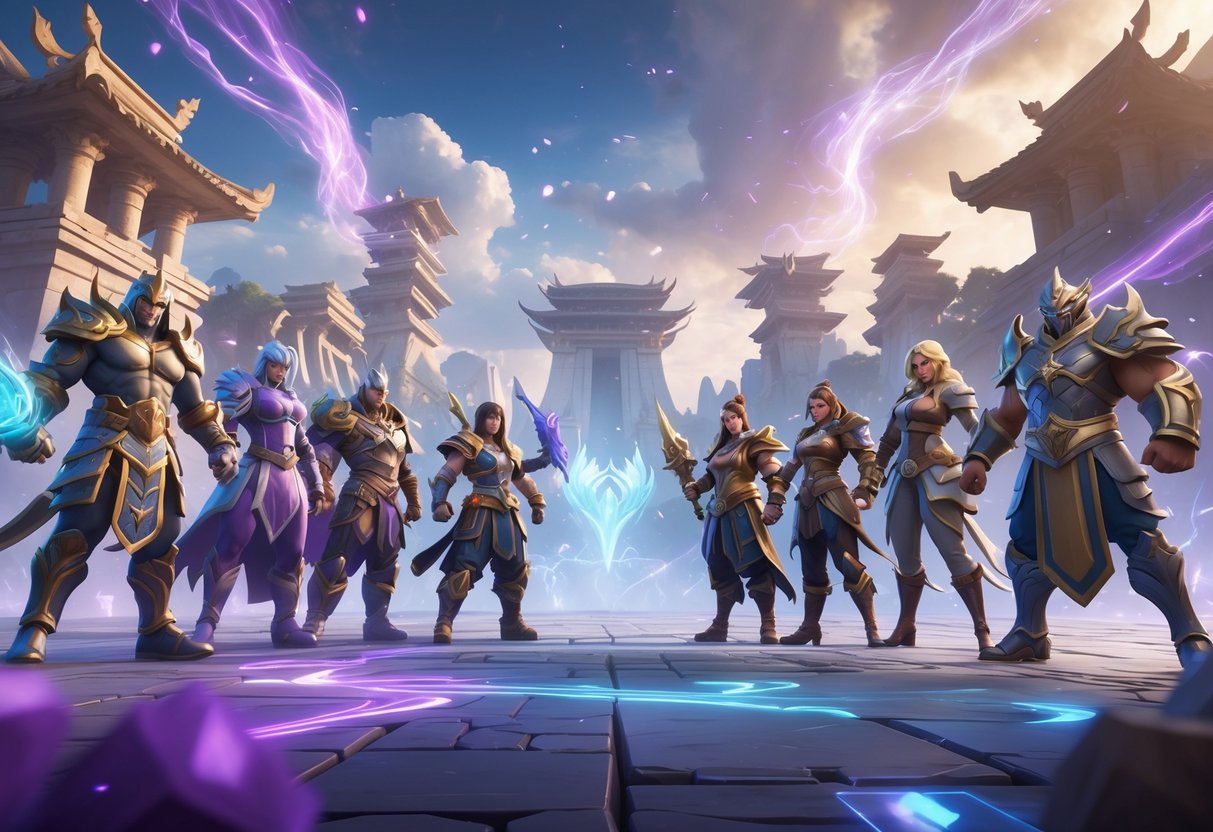
Honor of Kings brings more varied seasonal content with Chinese festival tie-ins. League of Legends Mobile focuses on cross-platform events that sync with the PC version. Both games hand out exclusive rewards during these times, but their approaches feel pretty different.
Exclusive Maps and Modes
Honor of Kings really shines with seasonal map makeovers celebrating Chinese New Year, Mid-Autumn Festival, and more. These aren’t just reskins—maps get new objectives and environmental effects.
During Spring Festival, you might see snow-covered battlefields and special jungle monsters that drop exclusive items. The game also rolls out temporary 3v3 modes and themed matches that shake up the usual gameplay.
League of Legends Mobile sticks with cross-platform consistency. Events like Spirit Blossom and Worlds celebrations bring the same content to both mobile and PC.
The mobile version sometimes gets exclusive ARAM variations and rotating modes not found on PC. These usually last 2-3 weeks and offer unique rewards.
Heads up: Some exclusive modes need you to own certain champions, so check before the event kicks off.
Limited-Time Skins and Rewards
Honor of Kings’ seasonal reward system feels more generous. You’ll get daily login bonuses and can earn premium skins just by playing during big festivals.
The gacha-style system guarantees legendary skins after a set number of tries. You can use event currency to buy exclusive cosmetics that don’t come back later.
League of Legends Mobile uses Riot’s usual model: battle passes and token systems. Wild Pass seasons let you earn both free and premium rewards.
Event-exclusive skins cost 990-1820 Wild Cores (£8-15), but honestly, the quality and effects often outshine Honor of Kings’ premium skins.
Quick tip: Both games give out plenty of free rewards—just focus on daily missions during events to grow your collection without opening your wallet.
Mobile Legends and Honor of Kings: Related Comparisons
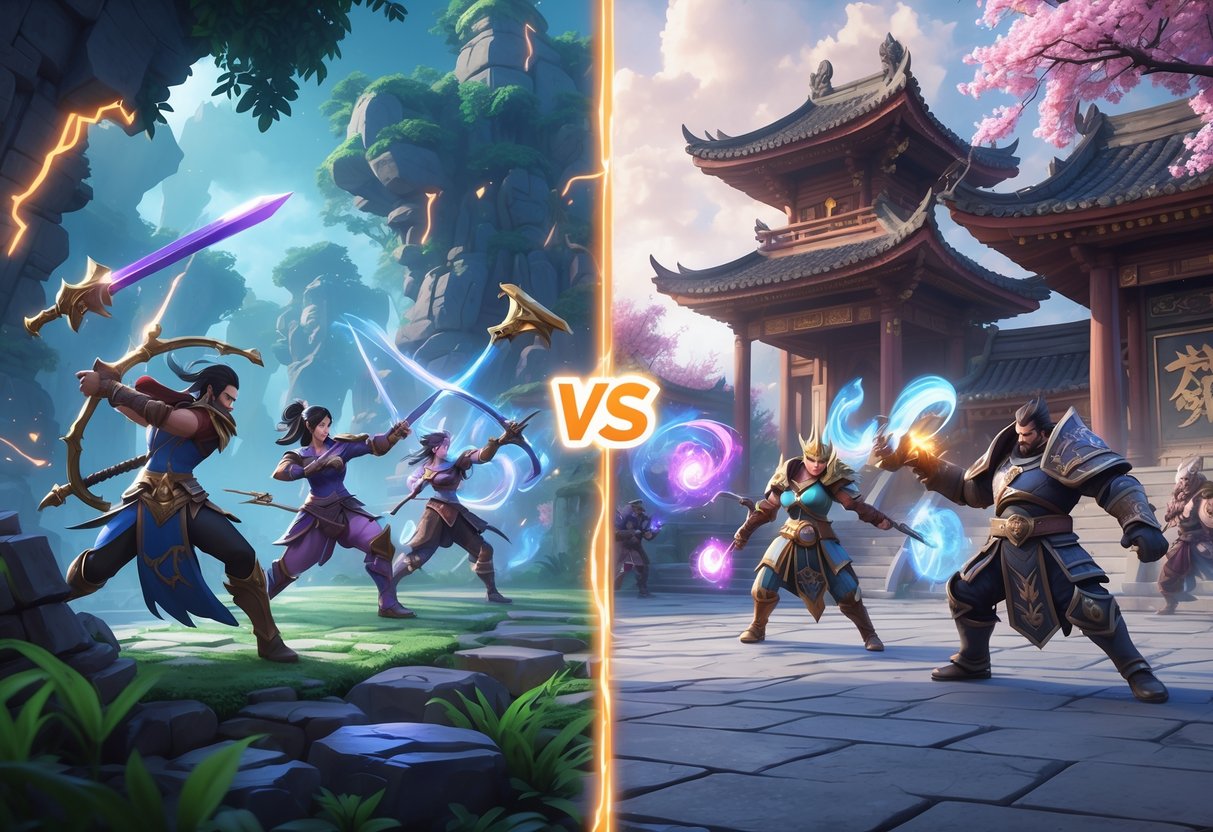
Mobile Legends and Honor of Kings share the core MOBA experience but offer distinct features that appeal to different players. Many gamers switch between these two, depending on their taste for art style, cultural themes, or competitive scenes.
Mobile Legends Features
Mobile Legends really leans into accessibility and short, punchy matches that usually wrap up in 10-15 minutes. The game’s bright, cartoonish graphics run surprisingly well, even on budget phones.
Key gameplay elements:
- Simple controls—great for beginners
- Classic MOBA setup with three lanes
- More than 100 original heroes, each with their own abilities
- Fast matchmaking that gets you into games quickly
You’ll find several modes besides just ranked battles. If you want to relax, you can jump into arcade modes or just practice against AI opponents.
Mobile Legends brings players from all over the world together. The developers put a lot of effort into localisation, so people can play in their own language, no matter where they live.
The community keeps buzzing on social media and forums.
Monetisation approach:
- Free-to-play, but you can buy cosmetic stuff if you want
- ML diamonds let you grab cool skins and hero looks
- No pay-to-win mechanics messing with matches
- Wins come down to skill and strategy, not your wallet
The esports scene just keeps growing. Big tournaments like the Mobile Legends World Championship pull in millions of viewers from everywhere.
Why Players Switch Between Games
People often bounce between both games, curious about how each one handles mobile MOBA gameplay. Honor of Kings tends to attract fans who want detailed graphics and a heavy dose of Chinese culture.
Common reasons for switching:
- Visual style – Honor of Kings goes for more realistic character art
- Cultural themes – Its heroes draw from Chinese myths and history
- Device needs – Honor of Kings runs best on mid-range phones or better
- Availability – Until 2024, Honor of Kings only existed in China
Some folks like Mobile Legends for its international vibe and established esports scene. Others dig the strategic depth and storytelling in Honor of Kings.
Performance differences matter:
- Mobile Legends runs smoother on older phones
- Honor of Kings demands more power for its graphics
- Both keep frame rates steady if your device can handle it
A lot of players just keep both games installed. They want to swap between art styles and hero lineups, and honestly, it’s usually a matter of taste—not that one game is truly better.
Long-Term Appeal and Player Retention

These games approach player retention in their own ways. Honor of Kings highlights hero mastery systems, while League of Legends: Wild Rift pushes ranked climbing and seasonal rewards.
Progression Systems
Honor of Kings tracks each champion’s mastery with its hero power system. You build up separate MMR for every hero, based on how you perform in matches.
This setup lets you chase multiple progression paths at once. You can focus on leveling up your favorite champions while raising your overall account level.
In ranked solo queue, the game hides usernames and just tags you as Player 1 or Player 2. No parties, just individuals.
This appeals to mobile games fans who want shorter, focused sessions. You can grind one hero’s progress without committing to marathon ranked sessions.
Wild Rift sticks to the classic League formula. Ranked tiers go from Iron to Challenger, and the visuals make it easy to track your progress.
Every few months, seasonal resets give everyone a clean slate. The gameplay style nudges you to play a variety of champions instead of just one.
Incentives to Keep Playing
Honor of Kings hands out big MMR bonuses for strong solo-ranked performances. If you crush a match, you’ll see bigger jumps in progression.
The hero mastery system turns progression into a bit of a collection game. Players often chase high power levels on lots of champions.
Regular events and flashy skins keep things fresh between big updates. The visuals help hold attention, which matters a lot in mobile games where sessions tend to be quick.
Wild Rift borrows retention tricks straight from PC League. Battle passes, ranked rewards, and champion releases all follow familiar patterns, just tweaked for mobile.
That link to PC League makes progress feel more meaningful for some. You’re not just grinding for nothing—it ties back to the bigger esports universe.
Both games hit platform limits that make long-term appeal a bit trickier compared to what you get on PC.
Frequently Asked Questions
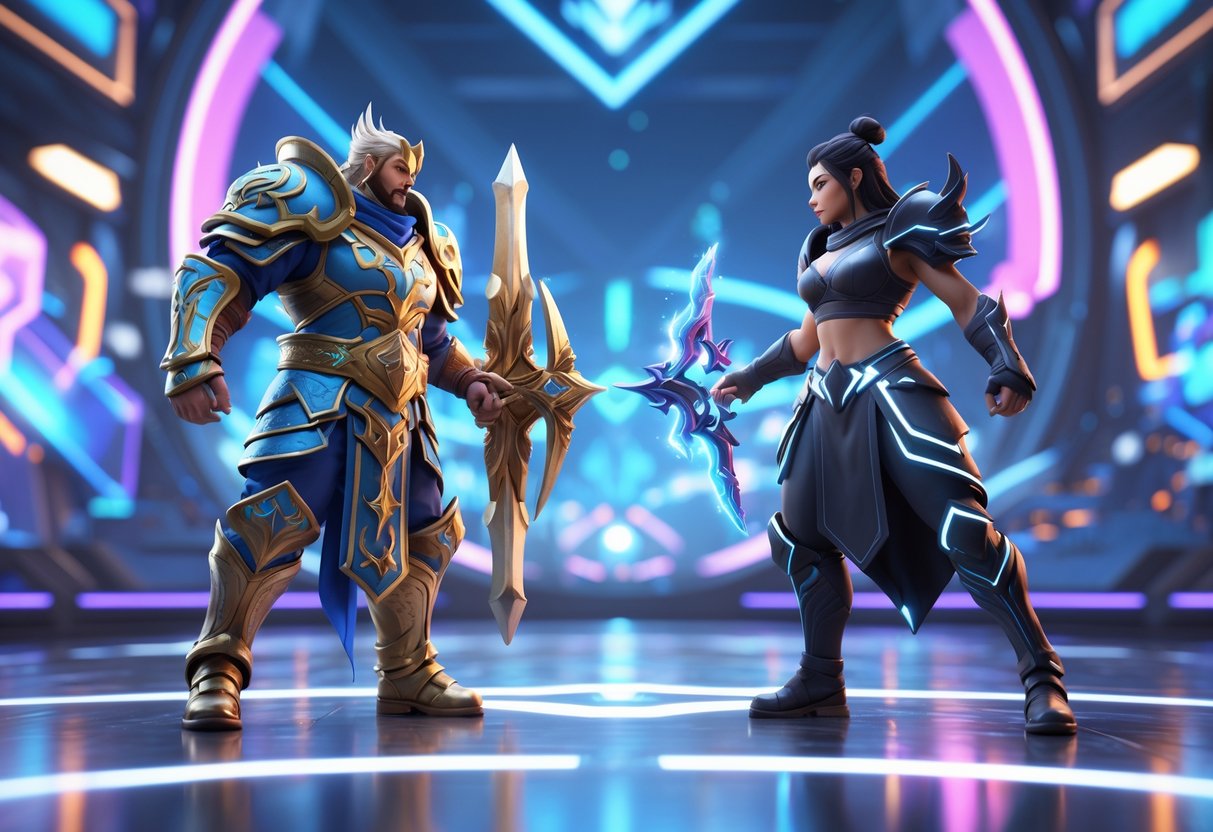
Players ask a lot about match length, character selection, and how microtransactions work. Switching between games also brings up questions about ranking and competitive scenes.
What are the distinctive gameplay differences between Honour of Kings and League of Legends: Wild Rift?
Match length stands out right away. Honour of Kings matches usually last 15-20 minutes, while Wild Rift games can stretch to 30-40 minutes.
Map size plays a big part. Honour of Kings uses smaller, tighter maps that get teams fighting sooner.
Roles feel different too. Supports in Honour of Kings—called “roamers”—move all over the map to help everyone. In Wild Rift, supports mostly stick with their marksman in the bottom lane.
Both stick to the 5v5 MOBA formula. You’re fighting across three lanes, trying to destroy the enemy base and protect your own.
Core mechanics don’t really change. You’ll still last-hit minions, contest jungle objectives, and teamfight in both games.
How do the hero selections compare between the two games?
Wild Rift splits heroes into eight classes, with lots of sub-categories: Controller, Fighter, Warrior, Mage, Marksman, Tank, Slayer, and Specialist.
Honour of Kings keeps it simpler with six main classes: Assassin, Warrior, Mage, Archer, Tank, and Support.
The themes really set them apart. Honour of Kings leans hard into Chinese mythology and history when designing champions.
Wild Rift takes inspiration from all over—mythology, fantasy, and more—without sticking to one culture.
Both games keep adding new champions. You’ll usually see 6-8 fresh faces every year in each title.
Can you break down the monetisation strategies used in both games?
Both games are free to download and play. You don’t have to spend a penny unless you want extras.
Cosmetics are the main money-makers. Skins, emotes, and flashy effects cost real cash but don’t impact gameplay.
Battle passes add seasonal rewards. Complete challenges and you’ll unlock exclusive content, usually for about £8-12 per season.
Champion unlocks work a bit differently. In Wild Rift, you can earn every champion through gameplay, though paying speeds it up.
Honour of Kings offers a similar system. Free currency builds up slowly, but you can unlock heroes instantly if you pay.
What are some tips for players transitioning from League of Legends: Wild Rift to Honour of Kings?
Get ready for faster matches. Games wrap up quicker, so early leads matter more than in Wild Rift.
Learn to play the roaming support. It’s the biggest shift from classic League and takes some map awareness.
Switch up your champion pool. Some skills carry over, but Honour of Kings heroes have their own quirks worth practicing.
Focus on making an impact early. With shorter matches, late-game strategies just don’t work as well.
Take time to learn the smaller map. Jungle paths and gank routes feel different, so you’ll need new muscle memory.
How does the ranking system in Honour of Kings differ from that in League of Legends: Wild Rift?
Both games use familiar tiered rankings: Bronze, Silver, Gold, Platinum, Diamond, and higher.
Seasons reset regularly, so you’ll see your rank shift every few months.
Ranked requirements can be stricter in Honour of Kings. Sometimes you need to own more champions before you can play ranked.
LP gains and losses look about the same. Win streaks help you climb, while losing slows you down.
End-of-season rewards usually include special skins and borders. Both games give exclusive cosmetics for reaching certain tiers.
What are the community and esports scenes like for each of the two titles?
Wild Rift really leans on League of Legends’ massive global community. You’ll see major tournaments pull in millions of viewers from all over the world.
Honour of Kings totally dominates in China, with more than 200 million registered players. The game just started pushing into the global market in June 2024.
Prize pools? Those can be wildly different depending on where you look. Chinese Honour of Kings events usually offer way more prize money than Wild Rift tournaments in the West.
People watch these games on different platforms, too. Wild Rift gets tons of attention on Twitch, while Honour of Kings streams mostly on Asian platforms.
Both games have solid paths for players who want to go pro. Semi-pro leagues and academy systems help new talent make their way onto competitive teams.









